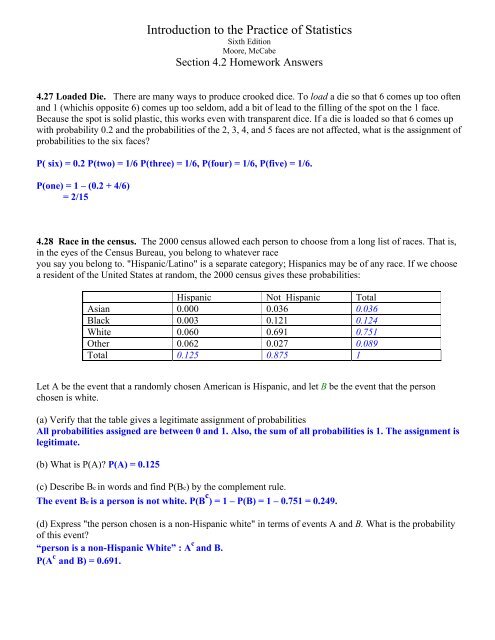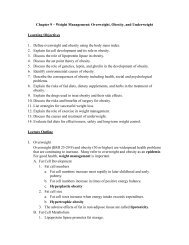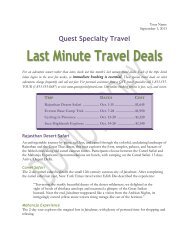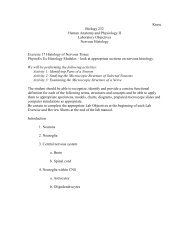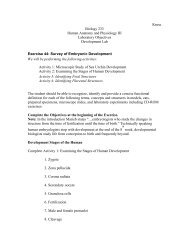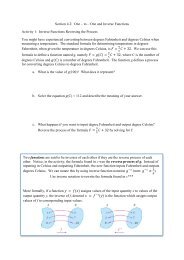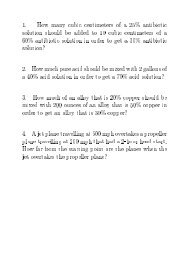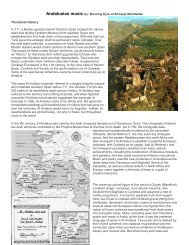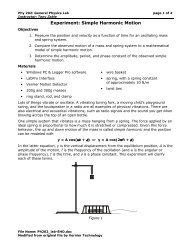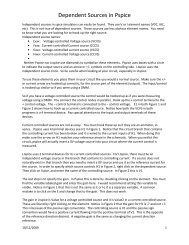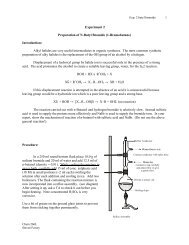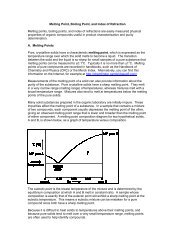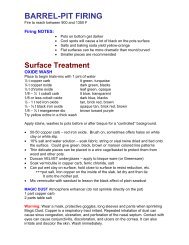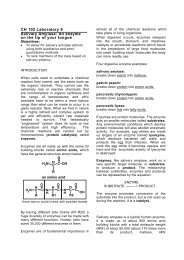Introduction to the Practice of Statistics - PCC
Introduction to the Practice of Statistics - PCC
Introduction to the Practice of Statistics - PCC
You also want an ePaper? Increase the reach of your titles
YUMPU automatically turns print PDFs into web optimized ePapers that Google loves.
<strong>Introduction</strong> <strong>to</strong> <strong>the</strong> <strong>Practice</strong> <strong>of</strong> <strong>Statistics</strong><br />
Sixth Edition<br />
Moore, McCabe<br />
Section 4.2 Homework Answers<br />
4.27 Loaded Die. There are many ways <strong>to</strong> produce crooked dice. To load a die so that 6 comes up <strong>to</strong>o <strong>of</strong>ten<br />
and 1 (whichis opposite 6) comes up <strong>to</strong>o seldom, add a bit <strong>of</strong> lead <strong>to</strong> <strong>the</strong> filling <strong>of</strong> <strong>the</strong> spot on <strong>the</strong> 1 face.<br />
Because <strong>the</strong> spot is solid plastic, this works even with transparent dice. If a die is loaded so that 6 comes up<br />
with probability 0.2 and <strong>the</strong> probabilities <strong>of</strong> <strong>the</strong> 2, 3, 4, and 5 faces are not affected, what is <strong>the</strong> assignment <strong>of</strong><br />
probabilities <strong>to</strong> <strong>the</strong> six faces?<br />
P( six) = 0.2 P(two) = 1/6 P(three) = 1/6, P(four) = 1/6, P(five) = 1/6.<br />
P(one) = 1 – (0.2 + 4/6)<br />
= 2/15<br />
4.28 Race in <strong>the</strong> census. The 2000 census allowed each person <strong>to</strong> choose from a long list <strong>of</strong> races. That is,<br />
in <strong>the</strong> eyes <strong>of</strong> <strong>the</strong> Census Bureau, you belong <strong>to</strong> whatever race<br />
you say you belong <strong>to</strong>. "Hispanic/Latino" is a separate category; Hispanics may be <strong>of</strong> any race. If we choose<br />
a resident <strong>of</strong> <strong>the</strong> United States at random, <strong>the</strong> 2000 census gives <strong>the</strong>se probabilities:<br />
Hispanic Not Hispanic Total<br />
Asian 0.000 0.036 0.036<br />
Black 0.003 0.121 0.124<br />
White 0.060 0.691 0.751<br />
O<strong>the</strong>r 0.062 0.027 0.089<br />
Total 0.125 0.875 1<br />
Let A be <strong>the</strong> event that a randomly chosen American is Hispanic, and let B be <strong>the</strong> event that <strong>the</strong> person<br />
chosen is white.<br />
(a) Verify that <strong>the</strong> table gives a legitimate assignment <strong>of</strong> probabilities<br />
All probabilities assigned are between 0 and 1. Also, <strong>the</strong> sum <strong>of</strong> all probabilities is 1. The assignment is<br />
legitimate.<br />
(b) What is P(A)? P(A) = 0.125<br />
(c) Describe Bc in words and find P(Bc) by <strong>the</strong> complement rule.<br />
The event Bc is a person is not white. P(B c ) = 1 – P(B) = 1 – 0.751 = 0.249.<br />
(d) Express "<strong>the</strong> person chosen is a non-Hispanic white" in terms <strong>of</strong> events A and B. What is <strong>the</strong> probability<br />
<strong>of</strong> this event?<br />
“person is a non-Hispanic White” : A c and B.<br />
P(A c and B) = 0.691.
4.29 Rh blood types. Human blood is typed as O, A, B, or AB and also as Rh-positive or Rh-negative.<br />
ABO type and Rhfac<strong>to</strong>r type are independent because <strong>the</strong>y are governed by different genes. In <strong>the</strong><br />
American population, 84% <strong>of</strong> people are Rh-positive. Use <strong>the</strong> information about ABO type in Exercise 4.21<br />
<strong>to</strong> give <strong>the</strong> probability distribution <strong>of</strong> blood type (ABO and Rh) for a randomly chosen person.<br />
First I am going <strong>to</strong> write down <strong>the</strong> given probabilities using function notation.<br />
P(Rh-positive) = 0.84 thus, P(Rh-negative) = 0.16<br />
Here is <strong>the</strong> table from problem 4.21.<br />
Blood Type O A B AB<br />
U.S. probability 0.45 0.40 0.11 0.04<br />
Next we go through all possible combinations.<br />
P(Rh-positive AND O) = P(Rh-positve)P(O)<br />
= 0.84(0.45) This calculation is correct because we know we have independence.<br />
We continue in <strong>the</strong> same manner <strong>to</strong> get <strong>the</strong> rest.<br />
P(Rh-positive AND A) = 0.84(0.4)<br />
P(Rh-positive AND B) = 0.84(0.11)<br />
P(Rh-positive AND AB) = 0.84(0.04)<br />
P(Rh-negative AND O) = 0.16(0.45)<br />
P(Rh-negative AND A) = 0.16(0.40)<br />
P(Rh-negative AND B) = 0.16(0.11)<br />
P(Rh-negative AND AB) = 0.16(0.04)<br />
4.30 Are <strong>the</strong> events independent? Exercise 4.28 assigns probabilities for <strong>the</strong> ethnic background <strong>of</strong> a<br />
randomly chosen resident <strong>of</strong> <strong>the</strong> United States. Let A be <strong>the</strong> event that <strong>the</strong> person chosen is Hispanic, and let<br />
B be <strong>the</strong> event that he or she is white. Are <strong>the</strong> events A and B independent? How do you know?<br />
I will use two approaches. The first uses <strong>the</strong> formula P(A | B) = P(A) this is only true if we have<br />
independence.<br />
P(Hispanic | White) =<br />
P( Hispanic and White)<br />
P(White)<br />
= 0.060<br />
0.751<br />
= 0.0799<br />
But P(Hispanic) = 0.125 which means that <strong>the</strong> 12.5% <strong>of</strong> <strong>the</strong> people in <strong>the</strong> U.S. in 2000 were Hispanic.<br />
However, if we look at <strong>the</strong> subset <strong>of</strong> <strong>the</strong> population “White” and ask what percentage <strong>of</strong> whites are<br />
hispanic <strong>the</strong> value is 7.99%. The percentage <strong>of</strong> Hipanics drops when we look at <strong>the</strong> subgroup “white”<br />
thus we do not have independence since <strong>the</strong> proportion changes. That is what independence deals with<br />
a change in probability. If <strong>the</strong> probability changes, we do not have independence.
Ano<strong>the</strong>r option <strong>to</strong> find if we have independence uses <strong>the</strong> formula P(A and B) = P(A)P(B) which only<br />
works if we have independence.<br />
P(Hispanic AND White) = 0.06 from <strong>the</strong> table.<br />
Now we can get <strong>the</strong> two o<strong>the</strong>r values from <strong>the</strong> table as well: P(Hispanic) = 0.125 P(White) = 0.751<br />
P(Hispanic)P(White) = 0.751(0.125)<br />
= 0.0939<br />
Since P(Hispanic AND White) ≠ P(Hispanic)P(White) we do not have independence.<br />
4.34 Universal blood donors. People with type O-negative blood are universal donors. That is, any patient<br />
can receive a transfusion <strong>of</strong> O-negative blood. Only 7% <strong>of</strong> <strong>the</strong> American population have O-negative<br />
blood. If 10 people appear at random <strong>to</strong> give blood, what is <strong>the</strong> probability that at least 1 <strong>of</strong> <strong>the</strong>m is a<br />
universal donor?<br />
What is <strong>the</strong> sample space? What are we observing? How many people have O-negative blood out <strong>of</strong><br />
ten people; S:{0, 1, 2, 3, 4, 5, 6, 7, 8, 9, 10} What do we want? P(1 or 2 or 3 or 4 or… or 10) we want<br />
<strong>the</strong> probability <strong>of</strong> observing one person or two people or three … with O-negative blood. It is easier <strong>to</strong><br />
answer <strong>the</strong> complement question: What is <strong>the</strong> complement <strong>of</strong> <strong>the</strong> event we want <strong>to</strong> witness {1, 2, 3, 4,<br />
5, …, 9, 10}? Well <strong>the</strong> complement is <strong>to</strong> observe 0 people having this type <strong>of</strong> blood.<br />
P(0) = P(1 st person no AND … AND 10 th person no) recall we have independence so…<br />
= (1 – 0.07) 10<br />
= .4840<br />
Thus, P(1 or 2 or 3 or 4 or… or 10) = 1 – 0.484<br />
= 0.516<br />
4.35 Disappearing Internet sites. Internet sites <strong>of</strong>ten vanish or move, so that references <strong>to</strong> <strong>the</strong>m can't be<br />
followed. In fact, 13% <strong>of</strong> Internet sites referenced in major scientific journals are lost within two years after<br />
publication.9 If a paper contains seven Internet references, what is <strong>the</strong> probability that all seven are still good<br />
two years later? What specific assumptions did you make in order <strong>to</strong> calculate this probability?<br />
P(link lost, within 2 yrs) = 0.13<br />
P(link not lost, within 2 yrs) = 0.87<br />
P(link not lost AND link not lost AND … AND link not lost) = 0.87 7 ≈ 0.3773<br />
In order <strong>to</strong> calculate this I had <strong>to</strong> assume I had independence, which means <strong>the</strong> following. I am assuming<br />
that if a link is lost within two years, <strong>the</strong> probability <strong>of</strong> ano<strong>the</strong>r link not being lost has not changed from <strong>the</strong><br />
stated 13%. On a practical matter, suppose you knew that all seven links resided on <strong>the</strong> same server, <strong>the</strong>n<br />
<strong>the</strong> independence assumption would not apply. Why? Because one can reason that if <strong>the</strong> links all reside on<br />
<strong>the</strong> same server, <strong>the</strong> manager <strong>of</strong> <strong>the</strong> server might decide <strong>to</strong> sever all links, or if <strong>the</strong> server goes down, <strong>the</strong>n all<br />
<strong>the</strong> links go down. The fact that <strong>the</strong>y all reside on <strong>the</strong> same server, would put in question <strong>the</strong> independence<br />
<strong>of</strong> <strong>the</strong>ir survival.
4.36 Random digit dialing. Most sample surveys use random digit dialing equipment <strong>to</strong> call residential<br />
telephone numbers at random. The telephone polling firm Zogby International reports that <strong>the</strong><br />
probability that a call reaches a live person is 0.2. Calls are independent.<br />
(a) A polling firm places 5 calls. What is <strong>the</strong> probability that none <strong>of</strong> <strong>the</strong>m reaches a person?<br />
What is <strong>the</strong> probability that a person is not reached, P(no reach) = 1 – 0.2 = 0.8<br />
The question asks for none <strong>of</strong> <strong>the</strong> five calls <strong>to</strong> reach a person.<br />
P(no reach AND no reach AND no reach AND no reach AND no reach) = 0.8 5 ≈ 0.3277<br />
(b) When calls are made <strong>to</strong> New York City, <strong>the</strong> probability <strong>of</strong> reaching a person is only 0.08. What is <strong>the</strong><br />
probability that none <strong>of</strong> 5 calls made <strong>to</strong> New York City reaches a person?<br />
P(no reach AND no reach AND no reach AND no reach AND no reach) = 0.92 5 ≈ 0.6591<br />
4.39 Random walks and s<strong>to</strong>ck prices. The "random walk" <strong>the</strong>ory <strong>of</strong> securities prices holds that price<br />
movements in disjoint time periods are independent <strong>of</strong> each o<strong>the</strong>r. Suppose that we record only whe<strong>the</strong>r <strong>the</strong><br />
price is up or down each year, and that <strong>the</strong> probability that our portfolio rises in price in any one year is 0.65.<br />
(This probability is approximately correct for a portfolio containing equal dollar amounts <strong>of</strong> all common .<br />
s<strong>to</strong>cks listed on <strong>the</strong> New York S<strong>to</strong>ck Exchange.)<br />
First I am going <strong>to</strong> organize <strong>the</strong> given information.<br />
P(price up) = 0.65 P(price down) = 0.35 (we will have <strong>to</strong> assume that if <strong>the</strong> price remains flat that<br />
we can place it in one <strong>of</strong> <strong>the</strong> two mentioned categories).<br />
Notice we have independence.<br />
(a) What is <strong>the</strong> probability that our portfolio goes up for 3 consecutive years?<br />
P(price up AND price up AND price up) = 0.65 3 ≈ 0.2746<br />
(b) If you know that <strong>the</strong> portfolio has risen in price 2 years in a row, what probability do you assign<br />
<strong>to</strong> <strong>the</strong> event that if will go down next year?<br />
P(price down) = 0.35 since I have independence (it does not matter what occurred <strong>the</strong> previous<br />
year); that is, P(price down | price down) = 0.35.<br />
(c) What is <strong>the</strong> probability that <strong>the</strong> portfolio's value moves in. <strong>the</strong> same direction in both <strong>of</strong> <strong>the</strong> next<br />
2 years?<br />
P(down And down OR up And up) = P(down And down) + P(up And up)<br />
= 0.35 2 + 0.65 2<br />
= 0.545


